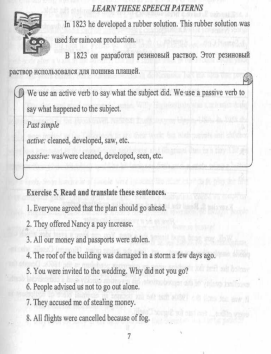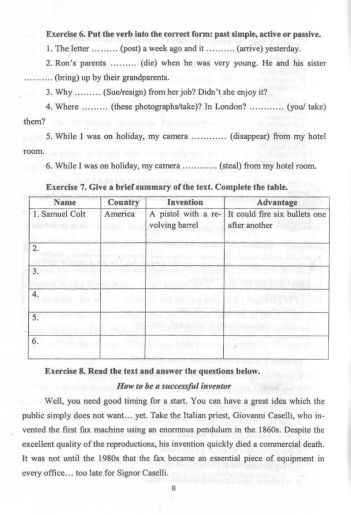
- •Introduction to the units
- •Unit 1. Inventors and their inventions
- •Unit 2. Technology in our lives
- •Technology in our lives
- •Why do many nuclear power stations have computer-controlled system?
- •Unit 3. Machines behaving badly
- •It is (not) worth
- •It would cost too much to repair this watch. It is
- •Glossary
- •Tasks to be done after reading the articles
- •Find the part of text 3 describing the advantages of a new digital camera.
- •Divide text 1 into several logical parts, give a heading to each of them.
Introduction to the units
Ni к in i and technology are the spheres of knowledge which are of current in- tcie.'.t iii socicty. The electronic age has changed our lives as communicating human bi'ings Ne w methods of sending and receiving information enable one to communicate with ;i bank or supermarket, interrogate a library catalogue or encyclopedia database. With the development of electronic systems of communication, new restricted language varieties have emerged. It seems likely that this trend will continue.
The aim of the course is to enlarge students’ hi-tech vocabulary; to practice talking about inventors and their inventions, to consider good and bad effects of technology. This course provides students with a critical understanding of how the things might be different in the future and how those differences will affect the way we might live.
«Science and Technology» is a supplementary study material for learning some aspects of these areas in addition to traditional textbook materials. Under the title «Science and Technology» you will find interesting study material: original texts, useful exercises, a test for controlling students’ knowledge and skills.
This study material can be used by students at all levels.
Unit 1. Inventors and their inventions
OBJECTIVE: to practice the active and passive verb forms;
to practice talking about inventors and their inventions.
Exercise 1. Read after the teacher.
-
perfect, chemist, aristocrat;
-
barrel, began, fantasy;
-
create, great;
-
production, run, combustion, success, industry, rubber;
-
bullet, enthusiast, solution;
-
ghost, most;
-
textile, reliable, design, financial, crisis;
-
pistol, engine, diesel.
Exercise 2. Form the derivatives and translate them.
Основа глагола + -er/-or = существительное со значением лица, производящего действие, орудия действия, e.g. to work - worker (рабочий)
-
to invent -
-
to develop -
-
to design-
-
to use -
-
to paint -
-
to create -
-
to produce -
-
to drive -
-
to make-
Exercise 3. Read and translate the text.
Inventors and their inventions Samuel Colt was an American. He lived in the 19th century. In 1836 he designed and patented a pistol. It was a pistol with a revolving barrel that could fire six
bullets one after another. It was the first pistol of its kind. Later there came many other pistols with six bullets.
Rudolf Diesel was a German engineer. He was bom in 1858 and died in 1913. In 1897 he invented a new internal combustion engine. This engine is known as a diesel. And it began a transport revolution in cars, lorries, trains and ships.
Samuel Finley Morse was bom in 1791. He died in 1872. He was a portrait painter. Then he became an inventor. For twelve years he tried to perfect the telegraph and he was a success. Later he invented the telegraphic dot-and-dash alphabet. Now it is known as Morse code. Morse code was not only one in America of that time. There were some others. But now we use Morse code all over the world.
Charles Makintosh lived from 1766 to 1843. He lived in Scotland and was a chemist by profession. He worked in a textile industry. In 1823 he developed a rubber solution. This rubber solution was used for raincoat production. Raincoats with this rubber solution didn’t allow water to penetrate. These raincoats were called makin- toshes. Now people all over the world use them in spring and in autumn.
Charles Rolls was bom in 1881 in Great Britain. He died in 1910. He was an aristocrat and businessman. He was especially interested in cars. Once he met another enthusiast of cars Henry Royce. Henry Royce was a famous car engineer. They decided to design the most comfortable and reliable car. At the beginning of the 20lh century it seemed to be a fantasy. But they worked hard and at last in 1907 they created the famous Rolls-Royce car. It was so comfortable and reliable that one of the models of Rolls-Royce cars «Silver Ghost» hadn’t changed greatly for 20 years since 1907.
Gottlieb Daimler and Charles Benz were two inventors. They lived in Germany. They were both interested in car production. At the end of the 19th century each of them designed a car. At the same time they organized two independent firms to produce them.
All the cars produced by the firm of Daimler were called «Mercedes». Mercedes was a daughter’s name of one of the stockholders of the firm. This man saved the firm of Daimler from financial crisis at the beginning of the 20th century. But after the World War I the firm of Daimler met with financial difficulties again.
6
Exercise 4. Find the words with similar meanings to these words.
-
to enable -
-
to invent -
-
to improve-
-
to start -
-
to name —
-
to design —
-
the benefit -
-
an occupation -


Money also helps. The Frenchman Denis Papin (1647-1712) had the idea for a steam engine almost a hundred years before the better-remembered Scotsman James Watt was even bom... but he never had enough money to build one.
You also need to be patient (it took scientists nearly eighty years to develop a light bulb which actually worked)... but not too patient. In the 1870s, Elisha Gray, a professional inventor from Chicago, developed plans for a telephone. Gray saw it as no more than «a beautiful toy», however. When he finally sent details of his invention to the Patent Office on February 14th 1876, it was too late; almost identical designs had arrived just two hours earlier... and the young man who sent them, Alexander Graham Bell, will always be remembered as the inventor of the telephone.
Of course what you really need is a great idea - but if you have not got one, a walk in the country and a careful look at nature can help. The Swiss scientist, George de Mestral, had the idea for Velcro when he found his clothes covered in the sticky seed pods after a walk in the country. During a similar walk in the French countryside some 250 years earlier, Rene-Antoine Ferchault de Reaumur had the idea that paper could be made from wood when he found an abandoned wasps’ nest.
You also need good commercial sense. Willy Higinbotham was a scientist doing nuclear research in the Brookhaven National Laboratoty in Upton, USA. In 1958 the public were invited to the Laboratory to see their work; but both parents and children were less interested in the complicated equipment and diagrams than in a tiny 120 cm screen with a white dot which could be hit back and forth over a «net» using a button and a knob. Soon hundreds of people were ignoring the other exhibits to play the first ever computer game - made from a simple laboratory instrument called an «oscilloscope». Higinbotham, however never made a cent from his invention: he thought people were only interested in the game because the other exhibits were so boring!
(From «Cutting Edge» by S. Cunningham, Longman, 1998)
-
Did Caselli’s «fax machine» actually work?
-
Who designed the first steam engine?
-
Who built the first steam engine?
-
Why does the story of the light bulb show that inventors need to be patient?
-
Who invented the first telephone?
-
What did the inventors of Velcro and of paper have in common?
-
What was the purpose of the exhibition at the National Laboratory at Upton in 1958?
-
Did Professor Higinbotham understand the potential of his «computer game»?
-
Which information in the article did you already know?
-
Which information most surprised you?
Exercise 9. Speak on the following.
-
If you could invent a new technological device, what would it be? Why would it be useful?
-
What will the library of the future be like?
-
How will family life be different one hundred years from now?
-
What will your chosen career be like one hundred years from now? Will it still exist?
